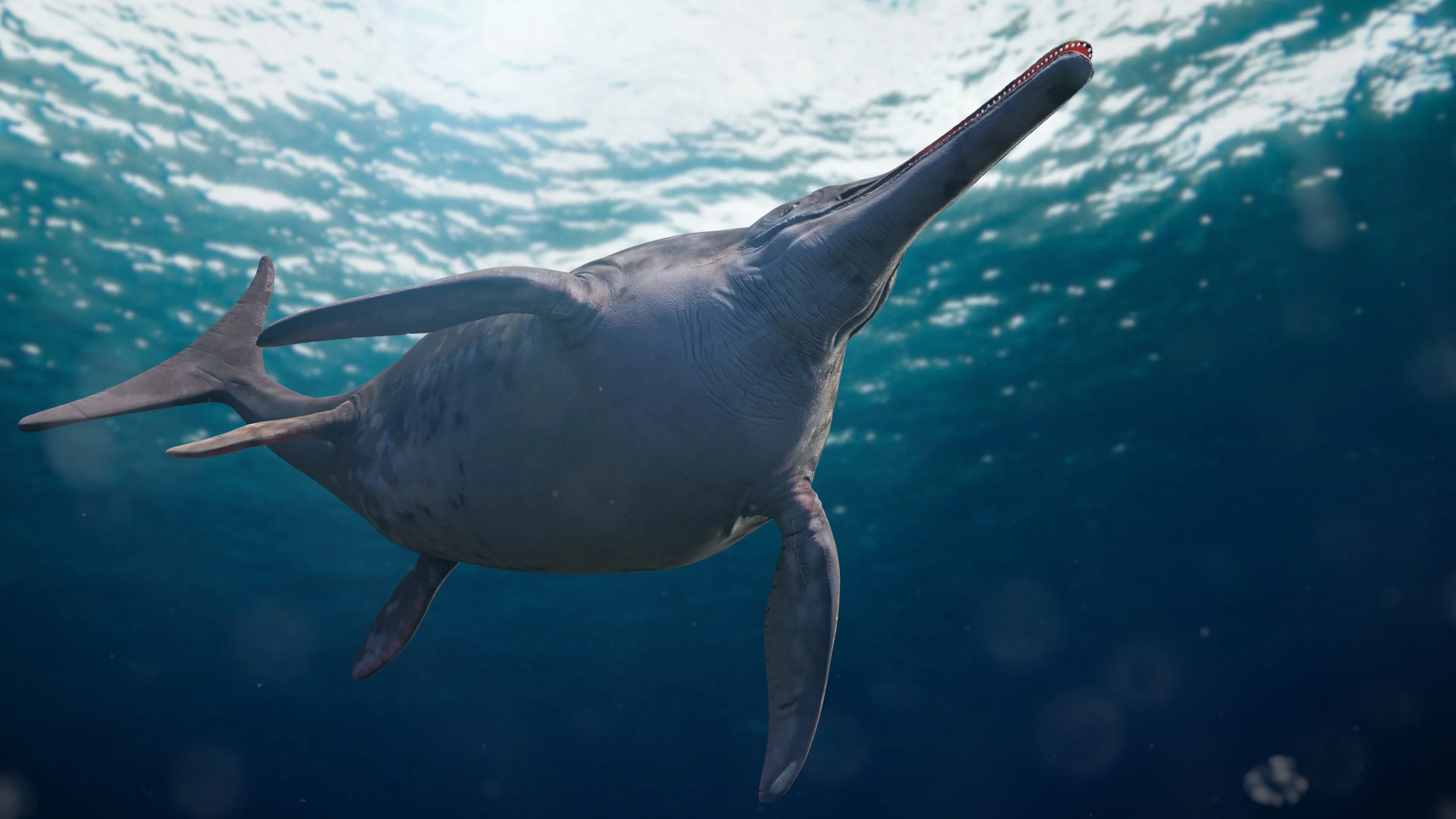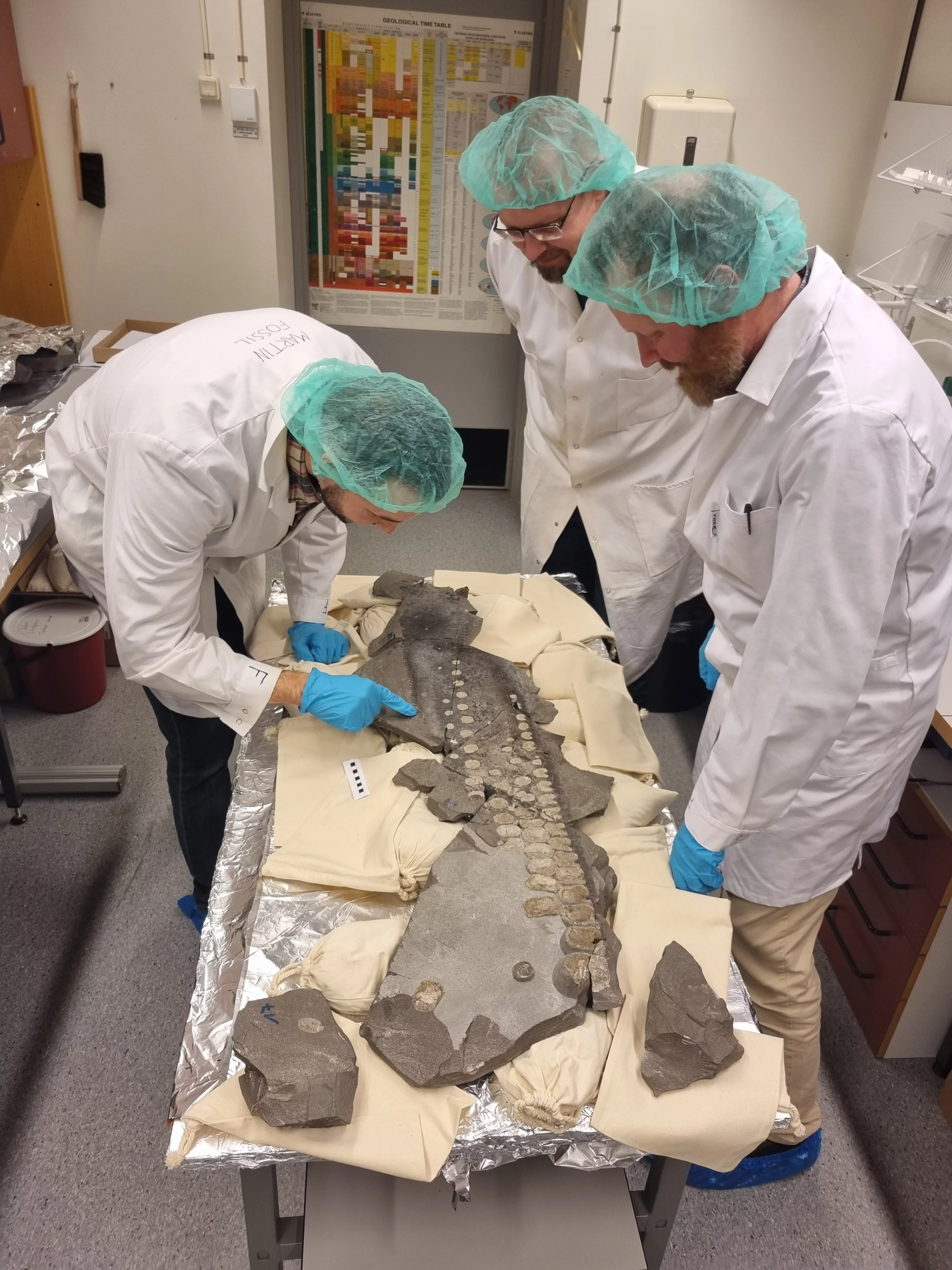Using state-of-the-art X-ray microtomography at the Swiss Light Source SLS, operated by the Paul Scherrer Institute PSI, researchers have gained insights into the silent hunting techniques of a giant ichthyosaur – a marine predator that roamed the dimly lit oceans 183 million years ago.
In the twilight of the Jurassic period, a giant ruled the seas: Temnodontosaurus, an ichthyosaur that was more than ten metres long, with eyes the size of footballs. It glided virtually noiselessly through the dark waters – always on the lookout for prey. This marine predator relied on specialised stealth strategies: no eddies, no noise – advancing silently before making a lightning attack.
What may sound like a scene from a wildlife documentary is actually based on the latest scientific findings. An international research team led by Johan Lindgren from Lund University has managed, for the first time, to analyse the soft tissue structures of an exceptionally well-preserved forefin of one of these marine giants. The structure of the forefin suggests an evolutionary adaptation to suppress noise when swimming – comparable to the serrated flight feathers of an owl, which glides through the night almost without a sound. In order to determine the detailed structure of the soft tissue, the Temnodontosaurus’s forefin was sent on a journey – to undergo X-ray tomography at the Swiss Light Source SLS in Villigen.
From land animal to silent leviathan
Ichthyosaurs lived on Earth between 250 and 90 million years ago, making them one of the most successful groups of marine tetrapods – four-limbed vertebrates – that we know of. Like modern whales, these ancient aquatic reptiles descended from land-dwelling animals that gradually adapted fully to life in the ocean by developing fins and streamlined, almost dolphin-like bodies.
The new study, published in the journal Nature, describes an almost complete forefin of the largest ocean megapredator during the Early Jurassic. “The wing-like shape of the flippers, the absence of bones at the distal end – the part furthest from the body – the longitudinal skin structures and the distinctly jagged trailing edge indicate that this massive animal had developed means of minimising noise when swimming,” explains Johan Lindgren, the study’s lead author, who specialises in the analysis of fossilised soft tissues in marine reptiles. This means that the ichthyosaur must have moved through the water almost noiselessly. “We have never before seen such sophisticated evolutionary adaptations in a marine animal.”
Although many unusual ichthyosaurs have been found in which the soft tissue has been preserved, even including some with complete body outlines, the known soft parts have so far been restricted to a small group of dolphin-sized species. The new discovery is remarkable in that it represents the first soft tissue of a large ichthyosaur. Also, the structure of the flipper is unlike that of any other known aquatic animal, living or extinct. Its jagged rear edge is reinforced by novel rod-like mineralised structures, which the team refers to as “chondroderms”. The fossilised fin was discovered by chance at a road construction site near Dotternhausen in southern Germany – by fossil collector Georg Göltz, a co-author of the study, who was looking out for other fossils there.
High-tech methods reveal prehistoric stealth technology
To better understand the structures preserved in the fossil, the fin underwent a series of highly sensitive procedures. Synchrotron-based X-ray microtomography at the TOMCAT beamline of the SLS at PSI played a key role. “The high resolution and high contrast of our tomography procedure meant that we were able to visualise the fine internal structure of the chondroderms in three dimensions,” says Federica Marone, a beamline scientist at PSI’s Center for Photon Science. “This imaging technique was crucial to helping us understand the mechanical function of the rod-like reinforcements –particularly their role in minimising noise while swimming.”
In addition to tomography, other state-of-the-art techniques were employed, including mass spectrometry and infrared microspectroscopy to analyse organic components. Furthermore, a virtual model of the fin was created. Numerical simulations of fluid flow demonstrated how Temnodontosaurus used its serrated fin to swim almost silently – providing perfect acoustic concealment. An international, multidisciplinary team of palaeontologists, engineers, chemists, biologists and physicists contributed to the success of the study.
Although the ichthyosaur has long been extinct, its evolutionary design could still be relevant today. “Noise pollution due to shipping, offshore facilities and sonar technology is having an increasing negative impact on today’s marine wildlife. Understanding the natural attenuation of sound achieved by Temnodontosaurus could therefore stimulate the development of quieter underwater technologies,” says Johan Lindgren.
In future, research into fossilised structures like these will provide even more precise insights, as the upgrade to SLS 2.0 has made the Swiss Light Source more powerful than ever before. Higher spatial resolution, higher beam energies and shorter measurement times mean that even fragile fossils can be analysed in unprecedented detail and with unrivalled speed. “SLS 2.0 opens up new possibilities, especially for complex specimens such as this ichthyosaur fin – in terms of both image quality and the efficiency of data collection,” says Federica Marone.
Contact
Dr. Federica Marone
PSI Center for Photon Science
Paul Scherrer Institute PSI
+41 56 310 53 18
federica.marone@psi.ch
[English]
Original publication
-
Lindgren J, Lomax DR, Szász RZ, Marx M, Revstedt J, Göltz G, et al.
Adaptations for stealth in the wing-like flippers of a large ichthyosaur
Nature. 2025; 644: 976-983. https://doi.org/10.1038/s41586-025-09271-w
DORA PSI



